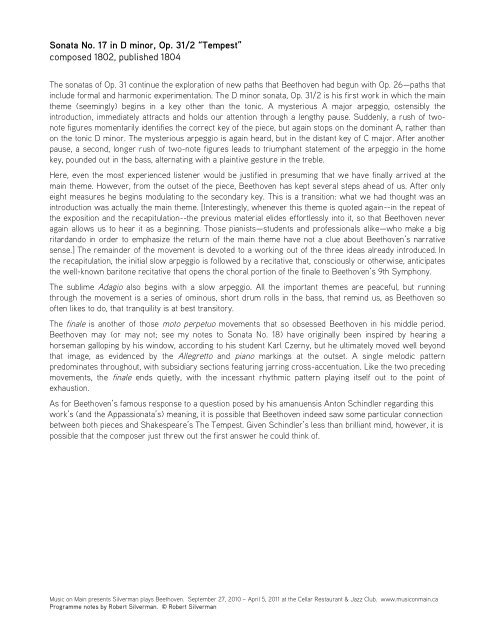beethoven's 32 piano sonatas robert silverman - Music on Main
beethoven's 32 piano sonatas robert silverman - Music on Main
beethoven's 32 piano sonatas robert silverman - Music on Main
You also want an ePaper? Increase the reach of your titles
YUMPU automatically turns print PDFs into web optimized ePapers that Google loves.
S<strong>on</strong>ata No. 17 in D minor, Op. 31/2 “Tempest”<br />
composed 1802, published 1804<br />
The <str<strong>on</strong>g>s<strong>on</strong>atas</str<strong>on</strong>g> of Op. 31 c<strong>on</strong>tinue the explorati<strong>on</strong> of new paths that Beethoven had begun with Op. 26—paths that<br />
include formal and harm<strong>on</strong>ic experimentati<strong>on</strong>. The D minor s<strong>on</strong>ata, Op. 31/2 is his first work in which the main<br />
theme (seemingly) begins in a key other than the t<strong>on</strong>ic. A mysterious A major arpeggio, ostensibly the<br />
introducti<strong>on</strong>, immediately attracts and holds our attenti<strong>on</strong> through a lengthy pause. Suddenly, a rush of tw<strong>on</strong>ote<br />
figures momentarily identifies the correct key of the piece, but again stops <strong>on</strong> the dominant A, rather than<br />
<strong>on</strong> the t<strong>on</strong>ic D minor. The mysterious arpeggio is again heard, but in the distant key of C major. After another<br />
pause, a sec<strong>on</strong>d, l<strong>on</strong>ger rush of two-note figures leads to triumphant statement of the arpeggio in the home<br />
key, pounded out in the bass, alternating with a plaintive gesture in the treble.<br />
Here, even the most experienced listener would be justified in presuming that we have finally arrived at the<br />
main theme. However, from the outset of the piece, Beethoven has kept several steps ahead of us. After <strong>on</strong>ly<br />
eight measures he begins modulating to the sec<strong>on</strong>dary key. This is a transiti<strong>on</strong>: what we had thought was an<br />
introducti<strong>on</strong> was actually the main theme. [Interestingly, whenever this theme is quoted again--in the repeat of<br />
the expositi<strong>on</strong> and the recapitulati<strong>on</strong>--the previous material elides effortlessly into it, so that Beethoven never<br />
again allows us to hear it as a beginning. Those pianists—students and professi<strong>on</strong>als alike—who make a big<br />
ritardando in order to emphasize the return of the main theme have not a clue about Beethoven’s narrative<br />
sense.] The remainder of the movement is devoted to a working out of the three ideas already introduced. In<br />
the recapitulati<strong>on</strong>, the initial slow arpeggio is followed by a recitative that, c<strong>on</strong>sciously or otherwise, anticipates<br />
the well-known barit<strong>on</strong>e recitative that opens the choral porti<strong>on</strong> of the finale to Beethoven’s 9th Symph<strong>on</strong>y.<br />
The sublime Adagio also begins with a slow arpeggio. All the important themes are peaceful, but running<br />
through the movement is a series of ominous, short drum rolls in the bass, that remind us, as Beethoven so<br />
often likes to do, that tranquility is at best transitory.<br />
The finale is another of those moto perpetuo movements that so obsessed Beethoven in his middle period.<br />
Beethoven may (or may not; see my notes to S<strong>on</strong>ata No. 18) have originally been inspired by hearing a<br />
horseman galloping by his window, according to his student Karl Czerny, but he ultimately moved well bey<strong>on</strong>d<br />
that image, as evidenced by the Allegretto and <str<strong>on</strong>g>piano</str<strong>on</strong>g> markings at the outset. A single melodic pattern<br />
predominates throughout, with subsidiary secti<strong>on</strong>s featuring jarring cross-accentuati<strong>on</strong>. Like the two preceding<br />
movements, the finale ends quietly, with the incessant rhythmic pattern playing itself out to the point of<br />
exhausti<strong>on</strong>.<br />
As for Beethoven’s famous resp<strong>on</strong>se to a questi<strong>on</strong> posed by his amanuensis Ant<strong>on</strong> Schindler regarding this<br />
work’s (and the Appassi<strong>on</strong>ata’s) meaning, it is possible that Beethoven indeed saw some particular c<strong>on</strong>necti<strong>on</strong><br />
between both pieces and Shakespeare’s The Tempest. Given Schindler’s less than brilliant mind, however, it is<br />
possible that the composer just threw out the first answer he could think of.<br />
<str<strong>on</strong>g>Music</str<strong>on</strong>g> <strong>on</strong> <strong>Main</strong> presents Silverman plays Beethoven. September 27, 2010 – April 5, 2011 at the Cellar Restaurant & Jazz Club. www.music<strong>on</strong>main.ca<br />
Programme notes by Robert Silverman. © Robert Silverman


